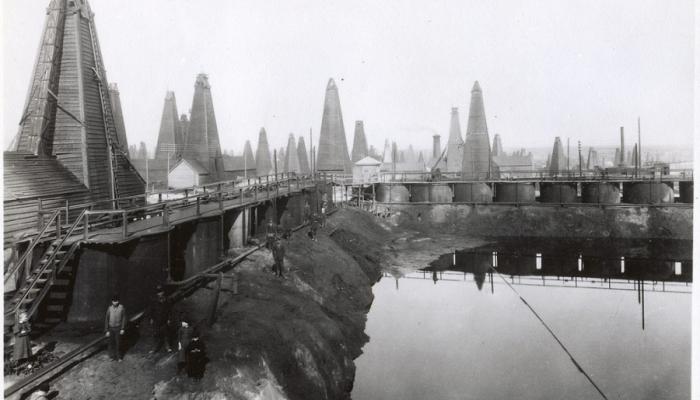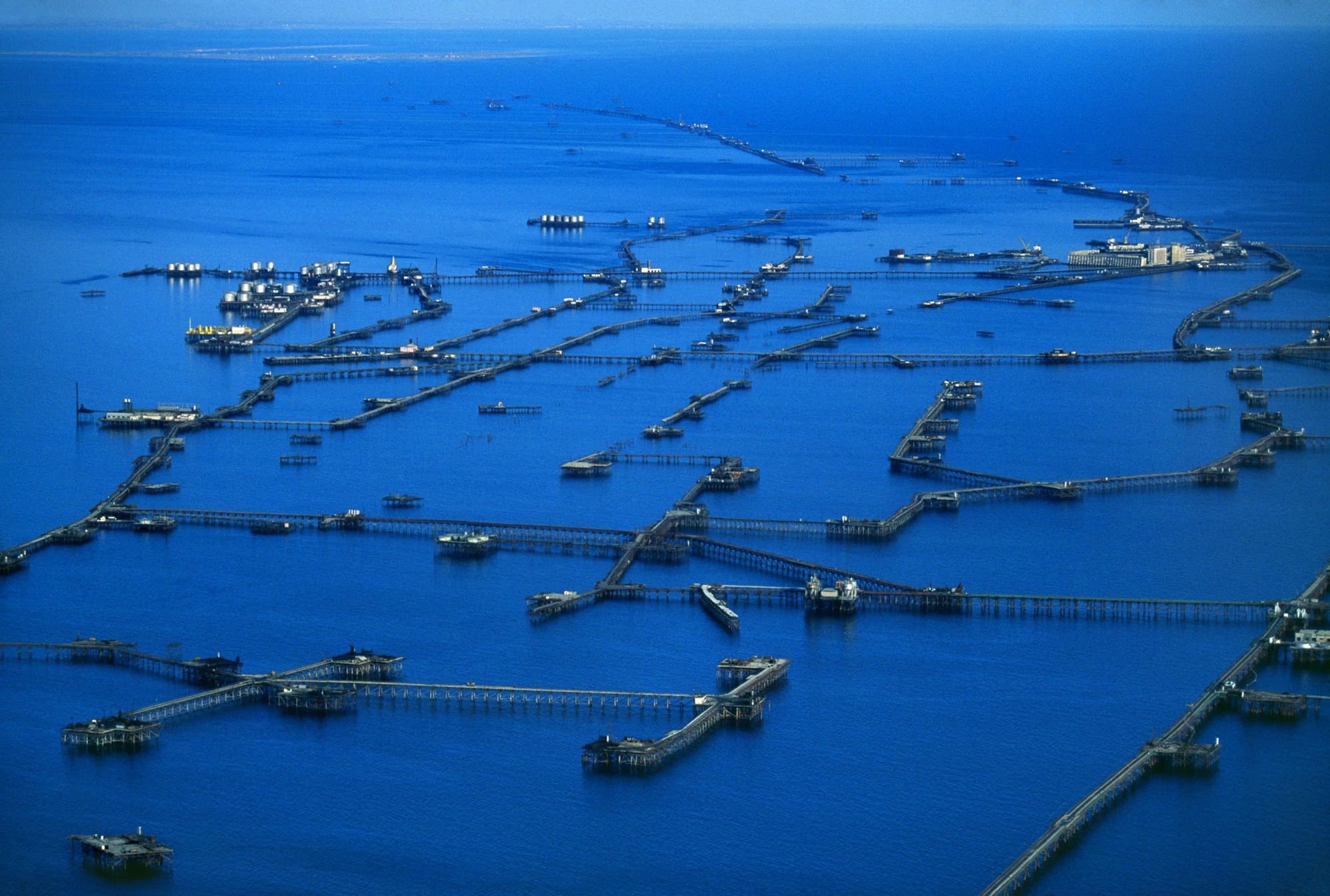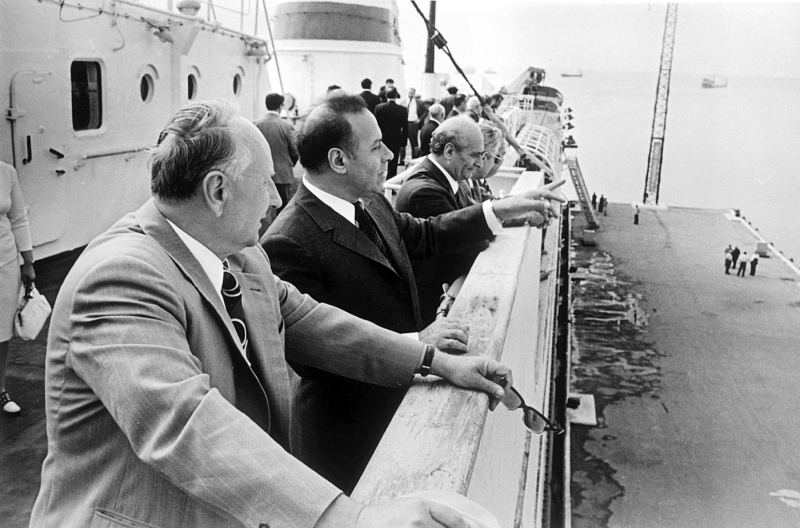HISTORY OF DEVELOPMENT OF OIL INDUSTRY
Azerbaijan and the Baku oil attracted the attention of the world companies
and businessmen in the second half of the 19th and early 20th centuries
and a number of foreign companies successfully operated there and ensured the
production of oil.
Heydar Aliyev.

The history of the oil industry of Azerbaijan dates back to the ancient period. Arabian historian, geographer, and traveler Ahmed Al-Belaruri pointed out the reliance of the economics of Absheron on oil in the ancient times, while Abu-Ishag Istekhri (11-10th centuries), Abu -d-Gasan Ali Masudi (the 10th century) provided information on the oil lands of Baku and white and black oil of Absheron. Italian traveler Marko Polo (the 13-14th centuries) reported on the incomes from the transportation of Baku oil to Eastern countries, German diplomat and traveler Adam Oleari (the 17th century — from Baku oil wells and Turkish Evliya Chelebi (the 17th century) — from oil fields and transportation of oil to Iran, Central Asia, and Turkey. The manuscript discovered on one of the oil wells in Balakhany (in the depth of 35 meters) showed that it was dug and commissioned by Allahyar Mamedhur in 1594. According to Amin Ahmed Razi (Iran 1601), nearly 500 similar oil wells existed in Baku in the early 16th century both white and black oil was produced in such wells. German traveler, doctor, and naturalist Engelbert Kempfer visited Balakhany, Binegedi, and Surakhany fields of the Absheron peninsula in 1683 as the secretary of Sweden's embassy and depicted the transportation of oil from the Absheron peninsula to Iran, Central Asia, and North Caucasus. Baku resident Gasymbey Mansurbeyov ordered the digging of two offshore wells 18 and 30 kilometers away from the shore in 1803 (1798).
The history of the development of the Azerbaijani oil industry is divided into several stages which had each their own peculiarities.
The first stage started with the mechanical production of oil from the dug wells in 1847 and continued up to 1920. The years of 1847-1848 were characterized by the first production of industrial oil from the dug wells in Bibieybat and later Balakhany fields and the development of the oil industry of Azerbaijan started from that moment.
The early 19th century was characterized by the first production of oil from the manual well dug at Bibieybat 30 meters away from the seashore.
The first oil refinery was constructed in Baku in 1859. The kerosene plant was built by Djavad Melikov in Baku in 1863 and fridges were used in oil refining for the first time in the world. 15 oil refineries operated in 1867.

The development of well drilling technologies led to the discovery of a number of oil wells (Binegedi, Pirallahi, Surakhany, and others), the increase in the production of oil, the development of oil infrastructure and oil refining, and the creation of hundreds of companies engaged in oil production, refining and sales. The national bourgeoisie formed in Azerbaijan and Baku turned into one of the industrial centers of the world. The industrial method of oil production was first used in the Balakhany-Sabunchun-Romany oil field in the Absheron peninsula in 1871. Two laws "On the excise tax on oil wells and oil products" and "Sales of oil lands held by leaseholders to individuals were adopted for the improvement of the relations in the oil industry in 1872. 15 regions of Balakhany and 2 regions in Bibiehbat were first put on auction on December 31, 1872.
At that period the state unused lands were commissioned for 24 years for the exploration of oil and the development of new oil fields. The leaseholders had the right to export the oil they produced and to fix its price. Their net incomes made up 14-15% of the oil sold. The net capital invested into the oil industry accounted for only 4% of the whole investments in the 1870s. The volume of mixed capital with the participation of national capital made up nearly 10%. In the late 19th century 49 (24.8%) out of 167 entrepreneurs operating in the oil sector were Azerbaijanis. At that period the oil millionaires made a great contribution to the development of the oil industry (Hadjy Zeynalabdin Taghiyev, Isa bey Hadjinsky, Murtuz Mukhtarov, Shamsi Asadullayev, Seyid Mirbabayev, and others). The first stock oil company -Baku oil society was established in Baku in 1874. Swedish Nobel brothers arrived in Baku in 1873 and witnessed the economic growth connected with oil. At that period they owned a number of oil fields, oil refineries, oil tankers in the Caspian Sea, barges, railroads hotels, etc. The new oil refineries were constructed and commissioned in 1876 following the elimination of excise tax on oil products.
The first oil pipeline in Russia extending to 12 kilometers and communicating the Balakhany field with the Baku oil refinery was constructed in 1878. The total length of all pipelines communicating the Baku oil refineries with oil fields amounted to 230 kilometers in 1898. These pipelines transported 1 million tons of oil a year.

Baku-Batumi railway was constructed and commissioned in 1883. This fact played an important role in the export of oil and oil products to European states. Rothschild initiated financial and credit transactions in Baku and engaged in the sales of oil in 1883. The Caspian-Black Sea oil company of Rothschild was established in 1886. The bank of Rothschild controlled 42% of Baku oil export. Azerbaijan produced 11 million tons of oil in 1901 thus accounting for over 50% of the world's production of oil. Famous scientist D. I. Mendeleyev proposed the construction of the Baku-Batumi pipeline to ensure the transportation of Baku oil to the world market in 1880. The pipeline 200 mm in diameters extends to 833 kilometers. Its construction was initiated in 1897 and completed in 1907.
Azerbaijan had accounted for 109 stock companies before the nationalization of the oil industry in the country. Of them, 72 were of Russian capital (240 million rubles) and 37 of English capital (100 million pounds). Nobel brothers invested 30 million rubles in the oil industry in Azerbaijan. The oil company Hadjy-Cheleken owned by the richest oil entrepreneurs of that time Isa bey Hadjinsky invested 1.25 million pounds into the oil industry. Before the nationalization of the oil industry, Azerbaijan accounted for 270 oil-producing enterprises, 49 middle and small firms engaged in the digging of oil wells, 25 firms engaged in oil refining, over 100 mechanical departments, repair workshops, and others. Within the last period of that stage, oil industry experiences a hard situation (war, revolution, and others), and oil production declined

The second stage started in 1920 after the nationalization of the oil industry of Azerbaijan and covers the period offshore Neft Dashlary field in 1949. The production of oil reduced down to 2.4 million tons in 1921. Within the second stage due to the expansion of exploration works a number of new oil fields were discovered (especially Gala, Buzovna-Mashtagha, and others) and commissioned and the oil production reached the level of 23.6 million tons in 1941 thus making up 76% of the total volume of oil production in the USSR. Due to that S.A Vezirov (chief of Azerneftcombinat), R.H. Ismayilov (chief of association Azneftzavodlar), B.Q. Babazade (head geologist of Azizbeyneft), R. Ragimov (master of drilling), were the first oilmen attached to the title of the Heroes of Socialist Labor. Due to the removal of oil equipment and oil specialists to eastern regions (Tatarstan, Turkmenistan, Bashkiria, and others) in the period of the war of 1941-1945 Azerbaijan accounted for 11.1 million tons of oil production.
Well, No:1 942 meters in depth was commissioned to produce 100 tons of oil a day in Neft Dashlary on November 7, 1949, thus laying the foundation for offshore oil production. Agha Gurban Aliyev was the first geologist for the well.

The third stage started with the commissioning of the Neft Dashlary field in 1950 and the development of the offshore oil industry in Azerbaijan and continued up to 1969. During this stage the offshore exploration works expanded, a number of oil and gas fields were revealed and commissioned (Gum-Deniz, Sangachal-Divanni-Deniz-Khara-Zira island, Bulla-Deniz, Darwin pitcher, and offshore drilling (including exploration drilling), the technique and technology of hydrotechnological oil plants, and the infrastructure of offshore oil production developed.
During the said stage a number of new onshore oil and gas fields were discovered and commissioned (Kurovdagh, Mishovdagh, Kursanga, Garabaghly, Galmaz, Garadagh, and others). That time was characterized by the intensive development and operation of Neft Dashlary and other fields. An offshore field was established on the Estacada in the open sea for the first time in the world practice. The conduction of engineering and scientific and technical measures caused the inflow of capital to the country, the improvement of productivity through the saving of metals, and the decline in the prices for a ton of oil.

The fourth stage started in 1969 and is characterized by the rapid development of the oil and gas industry that dates back to the first period of Heydar Aliyev's government. A new stage commenced in the development of offshore oil production at that time. The association Khazardenizneft was established in 1970 and considering the experience of oilmen of Azerbaijan in the conduction of works in the sea the Ministry of Oil Industry of the USSR empowered the Azeri oilmen to carry out all the geological, drilling, operating, and other works in all the sectors of the Caspian Sea (the Caspian Sea was divided into sector).
The technical devices used in the Caspian Sea allowed working only on the depth of 40 meters. Almost all of the oil and gas fields were discovered in the Caspian Azeri sector at the depth of 40 meters at that time. The increase in the oil and gas production in the sea was due to the availability of greater oil and gas reserves in the lower depths. As the result of the policy of the national leader of the Azerbaijani people, Heydar Aliyev Azerbaijan was supplied with over 400 of 75 types of load-lifting boats, seismic, passenger, and other vessels in the 1970-1980s. A crane boat Azerbaijan with a capacity of 2500 tons started operating in the Caspian Sea. Moreover, the receipt of the Khazar type tip-up for the conduction of geological survey on the depth of 70 meters in the sea and the Shelf type drilling plants enabling to operate in the depth of 200 meters in the sea allowed exploring oil and gas fields in the deeper regions o the sea. As the result 8 new oil and gas fields were discovered in the late 1960s, the volume of oil reserves increased by 2, gas reserves by 3. The total production of oil and gas reached 27.1 million tons (standard fuel) in 1975. The number of drilling plants reached 11 in the 1980s and as the result of their operation, the fields rich in oil were discovered ( Azeri-Chirag-Gunashli) in the Azeri sector of the Caspian Sea at the depth of 80-350 meters.
At that time the construction of the unrivaled Plan of the Deep Sea basis in Baku, the allotment of USD 450 million in the Soviet Union for the purpose, and receipt of the license for the construction of this plant in Astrakhan were all due to the courage of late President Heydar Aliyev.
The fifth stage is characterized by the collapse of the USSR, the creation of the new oil strategy covering the period of independence, and the new history of Azerbaijan.



